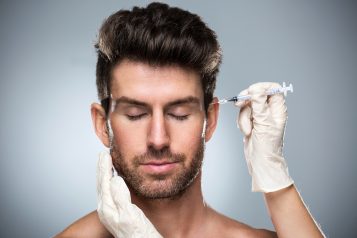If a Brazilian Butt Lift (BBL) is a procedure you've steered clear of because of supposed risks and controversy, let renowned plastic surgeon Dr. Samuel Lin and Dr. Hassan Alnaeem alleviate your concerns. The double board-certified Boston surgeon believes knowing everything about the procedure, including the potential risks, is the key to making an informed decision.
 Photo Credit: Shutterstock
Photo Credit: Shutterstock
What does a Brazilian Butt Lift (BBL) procedure involve?
It a surgical procedure that involves flanks, abdomen and thigh liposuction and transferring the liposuctioned fat to the buttocks. The goal of this procedure is to eliminate fat at the back, flanks and thighs and augment the buttock region.
How popular is this procedure in the United States these days?
According to the American Society for Aesthetic Plastic Surgery (ASAPS) statistics, in 2013 there were 11,527 procedures buttock augmentation procedures. In 2018, there were 24,099 buttock augmentation procedures with fat grafting. Currently, it is considered as the most common gluteal augmentation procedure.
How safe is the Brazilian Butt Lift Procedure?
Given the significant rate of mortality recently, there has been a Multi Plastic Surgery Society Gluteal Fat Grafting Task Force issued safety advisory urging practitioners to reevaluate their technique. all autopsies of deceased Brazilian Butt Lift patients have had these findings in common: 1) fat in the buttock muscles; 2) fat beneath the muscles; 3) damage to deep veins; 4) massive fat emboli (clot) in the heart and/or lungs. No post mortem has yet shown a case of death with fat only in the subcutaneous space; this means that surgeons have injected more deeply than they had intended.
What is the incidence of death in Brazilian butt lift procedure?
A recent survey performed by the American Society of Plastic Surgery estimates the death during Brazilian Butt Lift procedure to be around 1 in 2351. In Florida alone, there were three deaths in year 2017 and one recent death in in 2019.
What should I expect from my doctor during my visit before a Brazilian Butt Lift procedure?
Upon discussion with your plastic surgeon prior to surgery, the surgeon should perform a physical examination and ask all questions pertaining to your thorough medical history. The surgeon should ask if you are taking any medications or herbal remedies. Also, you should disclose to the surgeon any blood disorders and blood clots you suffered previously. The surgeon will perform the physical examination to look for any varicosities which may increase the risk of vessel injuries. The surgeon then may order preoperative tests and will discuss his/her technique, benefits and potential complications.
What are the complications that patient should be aware of prior to undergoing such procedure?
As with any surgical procedure, there are anesthesia-related complications and surgery-related complications. Depending of the anesthesia modality used, potential complications vary but may include nausea, vomiting, lung infection and aspiration, fluid imbalance and, rarely, death. Surgical related complications include but are not limited to infection, skin depression/dimpling, irregularities, asymmetry, bruising, fluid collections, fat reabsorption, bleeding, nerve injury and fat embolism (clot) to the lungs.
How can I make sure that my surgery will be safe?
Going to a board-certified plastic surgeon can help ensure that your practitioner is knowledgeable about the latest updates and safe practices with this procedure. Having your procedure in a certified surgicenter with a board certified anesthesiologist or hosipital setting. According to literature, a safe technique includes: large cannulas, continued motion during fat injection, superficial subcutaneous injection and avoid excessive filling. Risk of death should be discussed with every prospective Brazilian Butt Lift patient.
How long is the recovery period?
Patients should ensure they remain off the buttocks for at least 2 weeks post-op. Patients can go back to normal activity after a couple of weeks, but always consult with your surgeon before doing anything. Patients will wear a compressive garment to provide compression on the liposuction donor sites. Patients are encouraged to walk early and will be prescribed blood thinners if they meet certain criterion.
References:
Toledo LS. Gluteal augmentation with fat grafting: the Brazilian buttock technique: 30 years' experience. Clin Plast Surg. 2015;42(2):253-261.
Shah B. Complications in Gluteal Augmentation. Clin Plast Surg. 2018;45(2):179-186.
Mofid MM, Teitelbaum S, Suissa D, et al. Report on Mortality from Gluteal Fat Grafting: Recommendations from the ASERF Task Force. Aesthet Surg J. 2017;37(7):796-806.
Villanueva NL, Del Vecchio DA, Afrooz PN, Carboy JA, Rohrich RJ. Staying Safe during Gluteal Fat Transplantation. Plast Reconstr Surg. 2018;141(1):79-86.
Del Vecchio DA, Villanueva NL, Mohan R, et al. Clinical Implications of Gluteal Fat Graft Migration: A Dynamic Anatomical Study. Plast Reconstr Surg. 2018;142(5):1180-1192.
Ghavami A, Villanueva NL, Amirlak B. Gluteal Ligamentous Anatomy and Its Implication in Safe Buttock Augmentation. Plast Reconstr Surg. 2018;142(2):363-371.
Nicareta B, Pereira LH, Sterodimas A, Illouz YG. Autologous gluteal lipograft. Aesthetic Plast Surg. 2011;35(2):216-224.
Conde-Green A, Kotamarti V, Nini KT, et al. Fat Grafting for Gluteal Augmentation: A Systematic Review of the Literature and Meta-Analysis. Plast Reconstr Surg. 2016;138(3):437e-446e.
Pannucci CJ, Barta RJ, Portschy PR, et al. Assessment of postoperative venous thromboembolism risk in plastic surgery patients using the 2005 and 2010 Caprini Risk score. Plast Reconstr Surg. 2012;130(2):343-353.
For more information, visit Dr. Samuel Lin's social media:





















